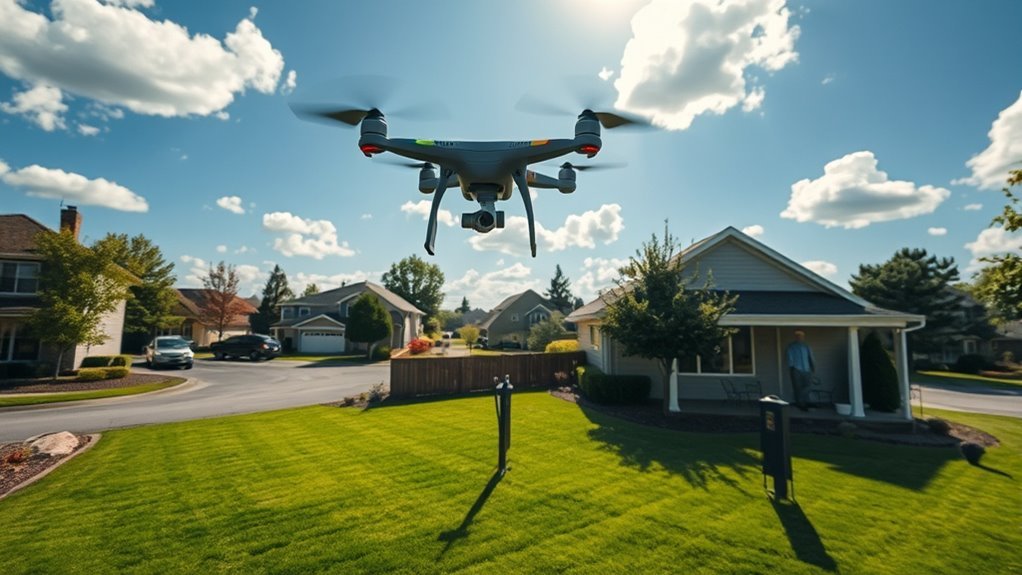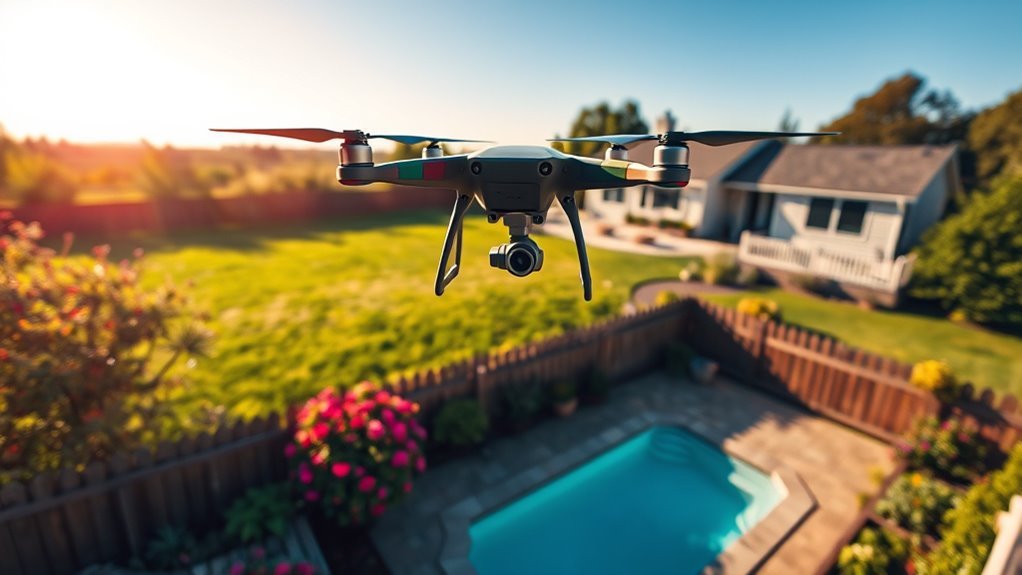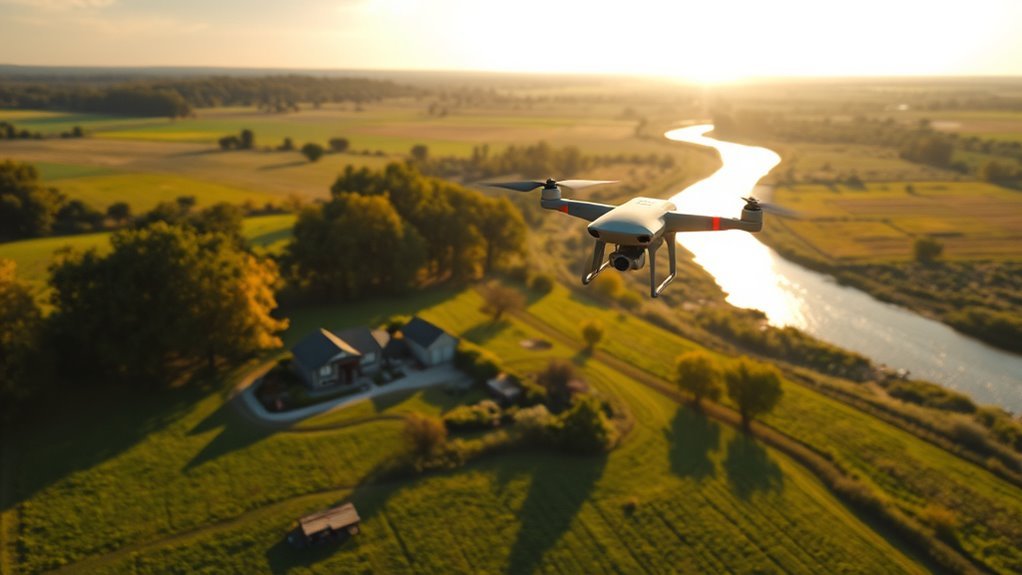To legally fly a drone over private property, you must first obtain permission from the property owner, ensuring transparency about your intentions. Familiarize yourself with both FAA guidelines and local regulations, as these may impose additional restrictions. Always respect privacy concerns by maintaining a safe altitude and avoiding intrusive maneuvers. Remember to maintain visual line-of-sight and adhere to no-fly zones. If you’d like to learn more about safe and responsible flying practices, keep exploring this topic.
Understanding Drone Regulations

When you’re flying a drone, understanding the regulations is vital, as it guarantees both your safety and compliance with the law. Drone technology offers incredible opportunities for creativity and exploration, but it also comes with responsibilities. You need to be aware of local laws that govern where and how you can operate your drone. For instance, avoiding restricted airspace is essential for flight safety. Make certain you know the altitude limits and keep your drone within visual line-of-sight. Additionally, respecting the privacy of others while flying guarantees you maintain good relationships within your community. By staying informed about these regulations, you can enjoy the freedom of flying your drone without compromising safety or legal standing.
Federal Aviation Administration (FAA) Guidelines

To guarantee a safe and compliant drone operation, you must familiarize yourself with the Federal Aviation Administration (FAA) guidelines. First, make sure your drone is registered if it weighs over 0.55 pounds. This registration is crucial for legal operation and accountability. Next, be aware of flight restrictions, which often include no-fly zones around airports, military bases, and certain populated areas. You’ll also need to maintain a visual line of sight with your drone at all times and fly below 400 feet to avoid interfering with manned aircraft. Adhering to these FAA guidelines not only protects your freedom to fly but also enhances safety for everyone involved. Stay informed and prepared to enjoy your drone experience responsibly.
State and Local Laws on Drone Use

While the FAA sets the overarching regulations for drone operation, state and local laws can impose additional restrictions that you need to be aware of. These state statutes and local ordinances can vary widely, affecting where and how you can fly your drone. Familiarizing yourself with these laws is essential to guarantee compliance and avoid penalties. It is important to understand that privacy regulations concerning unauthorized data collection over private property are also enforced in Connecticut. Additionally, many states have begun to adopt geo-fencing technologies to help drone operators comply with local airspace restrictions.
| Type of Law | Example Restriction | State/Local Authority |
|---|---|---|
| State Statute | No flying over state parks | State Government |
| Local Ordinance | Prohibition on night flights in urban areas | City Council |
| State Statute | Permit required for commercial use | State Aviation Authority |
Always check your local regulations before taking to the skies. Your freedom to operate a drone responsibly hinges on understanding these rules.
The Concept of Airspace Rights
Understanding airspace rights is essential for drone operators, as they navigate a complex legal landscape that governs where and how they can fly. Airspace ownership isn’t just about the ground beneath you; it extends vertically to a certain altitude. This means that flying too low could result in aerial trespass, infringing on a property owner’s rights.
Airspace rights are crucial for drone operators, as flying too low may lead to aerial trespass and legal complications.
- Federal laws typically govern airspace above 400 feet, while state regulations may impose additional restrictions.
- Local regulations may impose additional restrictions.
- Being aware of your surroundings can prevent legal issues.
- Compliance with drone regulations ensures that you can operate your drone legally and safely.
Knowing these nuances helps you operate within your rights while respecting others. Always keep in mind that your freedom to fly comes with the responsibility to understand the legal frameworks surrounding airspace ownership and aerial trespass.
Obtaining Permission From Property Owners
Obtaining permission from property owners is an essential step for drone operators, especially when flying at lower altitudes where airspace overlaps with private property. Always approach property owners with respect and transparency, discussing your intentions clearly. This practice not only demonstrates good drone etiquette but also helps build trust. When seeking permission, be mindful of property boundaries; know exactly where your drone will be flying and guarantee it doesn’t encroach on neighboring lands without consent. Consider the benefits of collaboration, as many property owners might appreciate the opportunity to view aerial imagery or have specific requests for your flight. Securing permission fosters goodwill, enabling you to enjoy the freedom of drone flying while respecting the rights of others.
Respecting Privacy Concerns
How can you guarantee that your drone flights respect the privacy of others? Understanding and adhering to privacy boundaries is vital for ethical drone operation. Here are some key considerations to keep in mind:
- Know the Law: Familiarize yourself with local regulations regarding drone use over private property.
- Flight Altitude: Maintain a safe altitude to avoid intruding on personal spaces, ensuring you’re above common privacy boundaries. Additionally, consider the drone’s advanced stability mechanisms that help maintain a consistent flight path.
- Communicate: If you’re unsure, reach out to property owners beforehand; transparency fosters trust and respects ethical considerations. Additionally, be aware that federal laws protecting aircraft may restrict your actions and ensure compliance with regulations.
Insurance Considerations for Drone Pilots
While flying a drone can be an exhilarating experience, it’s essential to contemplate the insurance implications that come with it. Acquiring liability coverage is important. This type of insurance protects you against potential claims resulting from accidents or damages caused by your drone. Without it, you could face significant financial repercussions.
When evaluating insurance policies, look for those tailored specifically for drone operators. These often cover various risks, including property damage or bodily injury. Make sure to read the fine print and understand any exclusions. Additionally, some states may require specific coverage levels, so staying informed about local regulations is significant. Prioritizing insurance will not only safeguard your freedom to fly but also provide peace of mind.
Understanding No-Fly Zones
Before you take to the skies, it’s essential to familiarize yourself with no-fly zones, as flying your drone in restricted areas can lead to legal issues and hefty fines. Understanding no fly restrictions is vital for responsible drone operation. Utilize mapping tools to identify these zones before your flight.
- Check local regulations and FAA guidelines.
- Use apps or websites that provide real-time no-fly zone information.
- Stay informed about temporary flight restrictions due to events or emergencies.
Best Practices for Responsible Drone Flying
What do you need to take into account for responsible drone flying? First, always prioritize safety measures. This means conducting pre-flight checks, keeping your drone within visual line of sight, and respecting altitude limits. Be mindful of people and property below; practicing ethical flying is essential. Avoid flying over private property without permission, and always respect the privacy of others. Additionally, familiarize yourself with local regulations and guidelines to guarantee compliance. FAA regulations can impose operational limits that you must consider while flying. Noise levels can also impact communities, so choose appropriate times for flying. Finally, be prepared for emergencies; having a plan can make a significant difference. By adhering to these best practices, you’ll not only enjoy the freedom of flying your drone but also foster a positive relationship with those around you. Understanding federal laws regulating drone use is crucial for ensuring compliance and safety while flying.
Resources for Drone Enthusiasts
As you dive deeper into the world of drones, you’ll find a wealth of resources designed to enhance your flying experience and knowledge. Whether you’re interested in perfecting your flying techniques or exploring the expansive domain of drone photography, these resources will empower you.
Explore a wealth of resources to enhance your drone flying skills and unleash your creativity in photography.
- Online Forums: Join communities where experienced pilots share tips and tricks. Engaging with fellow enthusiasts can also enhance your understanding of brand reputation and its impact on consumer choices.
- Tutorial Videos: YouTube is filled with content that covers everything from basic flying skills to advanced camera maneuvers.
- Books and eBooks: Look for titles that focus on drone operation, regulations, and photography techniques.
Additionally, understanding intelligent flight modes can greatly enhance your operational creativity and safety. With these tools at your disposal, you’ll elevate your skills and creativity, ensuring your flights are both enjoyable and compliant with regulations. Embrace the freedom to explore!
Frequently Asked Questions
Can I Fly My Drone at Night Over Private Property?
Curiosity stirs as you ponder flying your drone at night. You must adhere to night flight regulations and guarantee proper drone lighting requirements are met. Otherwise, you risk legal repercussions and jeopardize your freedom to fly.
What Happens if I Accidentally Damage Someone’s Property While Flying?
If you accidentally damage someone’s property while flying, your insurance coverage might help cover costs. However, you could face property liability claims. Always check your policy to guarantee you’re protected in such situations.
Are There Height Limits When Flying Over Private Property?
When flying your drone, consider that height restrictions apply. For instance, if you fly over a neighbor’s yard at 200 feet, you could breach legal boundaries. Always check local regulations to avoid potential conflicts.
Do I Need a License to Fly My Drone Commercially?
Yes, you’ll need a commercial license to fly your drone for profit. Familiarize yourself with drone regulations, including obtaining a Part 107 certificate, to guarantee you operate legally and release your aerial ambitions safely.
Can I Use My Drone for Photography Without Permission?
While capturing stunning aerial photography can be tempting, you’ll need to navigate drone regulations. Without permission, you risk legal entanglements and respect for others’ privacy, so always seek consent before soaring above private property.

